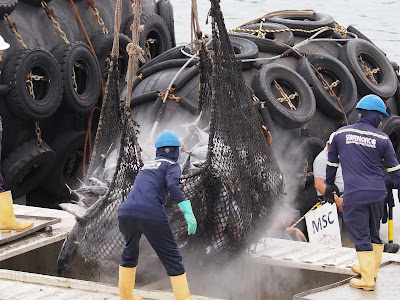We've had an interesting day in Manta, Ecuador! Naturally, I took way too many photos, so I'm going to post about this morning here and hopefully make another post about this afternoon's excursion tomorrow. I should have more time tomorrow since we'll be mostly around the ship. We sailed shortly after returning to the ship this evening, showered and had dinner and are headed to bed soon. Tomorrow morning we will wake up in Guayaquil, Ecuador and spend the day and night there before we sail on toward Chile.
Manta is an extremely busy port on Ecuador's central coast. It is known for its tuna fishing industry. We woke to the sight of huge ships unloading their catch while dozens more wait their turn to unload their catch.
Our room being on the 8th floor provided the perfect vantage point to watch the entire process of unloading tons and tons of tuna into the backs of custom built trucks to haul them to one of 20 local canneries. The doors on top opened back so that the fish could be dumped down into them, and then they could be unloaded through a door on the back (think dump truck).
I'm told that the tuna you see in these photos are the small ones! They will be canned and shipped worldwide. The large tuna are 6-7 feet long and they are used as steaks, sushi, etc.
It was amazing to see the sheer volume of fish that was being unloaded and the efficiency of all the dock workers to accomplish such a feat.
Hopefully the pictures will tell the story - and forgive me in advance for posting so many!
 |
| filling the nets of tuna to be lifted into waiting trucks |
 |
| fill 'er up! |
 | |
| positioning is everything! |
 |
| ...and into the hatch they go |
 |
| net after net loaded into waiting trucks |
 | |
| one side almost full, now to load the other |
 |
| black containers serve as bumpers between ships |
 |
| catch being dumped (L) while more tuna is loaded into net (R) |
 |
| net after net after net... |
 |
| up and away! |
Gloria told me that much tuna sold in America comes from Ecuador. It was either Chicken of the Sea or another brand that I remembered. Lj
ReplyDeleteYes, it is shipped all over the world and I think it goes to different processing plants and then sold under various brands. I did learn that albacore is a different fish. So apparently there are different kinds of tuna and I was told that some varieties are 6-7 feet in length!
DeleteWOW! I hope the ship featured tuna as one of the dinner choices! So now you are south of the equator? And instead of late/mid winter, it's late/mid summer? What time zone are you in? XOXO, SS
ReplyDeleteYes, we're south of the Equator and in the Eastern time zone. It's been hot ever since we left San Francisco! And believe it or not, there was NO tuna at dinner last night! Ronnie has been wanting a tuna fish sandwich since he boarded the ship but he hasn't seen one yet. He did have a tuna steak at the grill downstairs - just like a hamburger but instead of beef, it had a tuna steak in it. It tasted fine but it wasn't his idea of a tuna sandwich.
DeleteJan, sent all tuna pictures to Brenda and Adrienne. Adrienne a vegetarian and loves the tuna steaks and the way her dad fixes them for her when she visits. Great pictures of the tuna haul yesterday. Thanks for all your pictures.
ReplyDeleteIt was so much fun watching them. I took over 100 photos, now having to delete them, as I'm not sure my computer can hold them all if I keep this up! We are in Guayaduil today and it is hot! I hear it isn’t hot at home! Thank you for following along!
DeleteJan, you seem to be able to anticipate and answer questions that pop into my head. I was wondering what the huge pods were…and voila, they efficiently hold the nets. :-)
ReplyDeleteYour blogs are incredible- sharing your ‘city park’ excursion made me aware of what we take for granted.
Prayer - Lord, thank You for Jan who is managing to send home to us so many eye-opening experiences and pictures of Your world. Please keep them safe and well. In Jesus name, Amen
Thank you Karen! Actually, we kind of guessed that those big black containers hold nets (which we still think they probably do) but we also learned that they serve as "bumpers" between the ships when other ships unload their catch into the larger refrigerated ships. We were told that other ships (trawlers) use some type of system (sonar?) to spot the schools of tunas to catch them in their nets. When those ships are filled, they empty into the refrigerated ships and once it is full, they unload in port and it's off to the cannery.
Delete